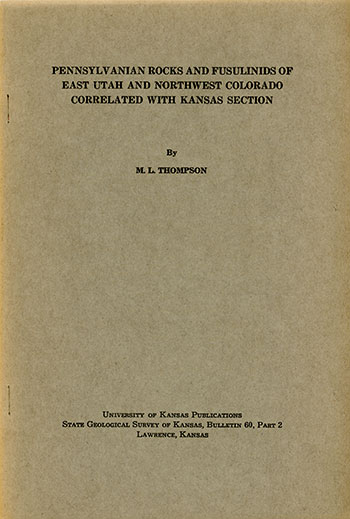Pennsylvanian Rocks and Fusulinids of East Utah and Northwest Colorado Correlated with Kansas Section
by M. L. Thompson

Originally published in 1945 as Kansas Geological Survey Bulletin 60, Part 2. This is, in general, the original text as published. The information has not been updated. An Acrobat PDF version (11 MB) is also available.
Abstract
Stratigraphic sections of Pennsylvanian rocks in the eastern Uinta Mountains of Utah and Colorado and of the lowermost Pennsylvanian in the eastern White River uplift area of northwestern Colorado are illustrated and discussed. Parts of the fusulinid faunas from these sections are described and illustrated. Largely on the basis of them, correlations are made with the stratigraphic section of the midcontinent region.
The Belden shale of the White River uplift is described as the Belden formation and limestones and shales of the Uinta Mountains, formerly referred to the upper part of the Brazer formation, are referred to it. The Pennsylvanian rocks in the eastern Uinta Mountains are divided, in ascending order, into the Belden formation, Hell's Canyon formation, Youghall formation, and Weber sandstone.
Four species of Millerella are described and illustrated from the Belden formation and several others are identified. As this fauna is composed entirely of Millerella, the Belden formation is referred to the Zone of Millerella and is correlated with the type section of the Morrowan of Arkansas and the Kearny formation of Kansas.
Species from the Hell's Canyon formation belonging to Millerella, Pseudostaffella, Eoschubertella, and Fusulinella are identified, 5 of them being described and illustrated. The Hell's Canyon formation is referred to the uppermost part of the Zone of Fusulinella. The Youghall formation contains an abundant fauna of Wedekindellina and Fusulina, 10 forms of which are described and illustrated. The Youghall formation is referred to the Zone of Fusulina and is correlated with the Cherokee of Kansas and Iowa.
No fossils were found in the Weber sandstone. Its age was not determined.
Kansas Geological Survey, Geology
Placed on web Sept. 10, 2017; originally published Oct. 15, 1945.
Comments to webadmin@kgs.ku.edu
The URL for this page is http://www.kgs.ku.edu/Publications/Bulletins/60_2/index.html